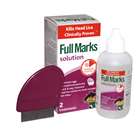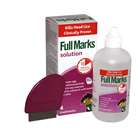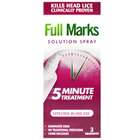Head lice are tiny, wingless insects. Even when fully grown they are still only the size of a sesame seed. Head lice are in fact harmless, however they can cause your child’s head to itch. Head lice cannot survive the cold and so this is why they cling to our hair, keeping close to the warmth of our heads. They have been making a nuisance of themselves for thousands of years. Fortunately, getting rid of them nowadays need only take a ten minute treatment time!
Full Marks works in three stages; Detection, Treatment and Removal.
Detection: Find live lice by 'detection combing' with a very fine toothed comb, Full Marks Detection comb is perfect.
Treatment: Full Marks offer a variety of solutions for quick and effective removal of lice. Full Marks Solution kills head lice with a 10 minute treatment and is suitable for asthma sufferers, eczema sufferers, people who cannot use insecticides or those who prefer non-chemical products as it is pesticide-free. It works by coating lice in a special low odour substance that causes them to dehydrate and die. As this has a physical action on the lice, there is no known resistance.
Removal: Eggs left in the hair after treatment will not hatch or cause any harm, but that does not stop most of us wanting to get rid of them anyway!
How are head lice caught?
Head lice simply crawl from one person's hair into another's when the two people's heads are in close contact. Head lice can't jump or fly.
What's the best way to detect head lice?
Regular detection combing using a Full Marks Detector Comb. You should also check for head lice in this way if anyone in the family has been in close contact with someone who has head lice
Why do head lice cause itching?
There are a number of reasons – one is that the thought of head lice is enough to make some people itch. Others will have a reaction to the saliva the louse injects when they feed on the scalp. This itching can take weeks to develop or not develop at all. Itching doesn't mean you have head lice – just as no itching doesn't mean you haven't.
What are nits?
Nits are white, empty egg shells left behind when a louse has hatched. They are glued to the hairs – and can be difficult to remove. Using a 'nit comb' or gripping the eggshell between tweezers may help.
Will shampooing remove head lice?
No. Head lice breath through holes in their bodies called spiracles. Ordinary shampoo just causes them to close these spiracles and wait until the washing stops.
What if I have asthma, eczema or sensitive skin?
There are a number of products available for people with these conditions. The best thing to do is to speak to your pharmacist, nurse or doctor for advice. Full Marks Solution is suitable for use by eczema and asthma sufferers. Derbac M is suitable for use by asthma sufferers and for use on sensitive skin.
How can I stop my children from getting head lice?
You can't, but with regular detection combing you can find head lice and get rid of them before their numbers grow
How quickly could I catch head lice after a successful treatment?
Straight away. It is important to remember that a treatment doesn't prevent head lice from immediately being caught again. This is why Contact Tracing is so important – as it reduces the chance of this happening.
Do I need to tell anyone if I find a head lice infestation?
It is a good idea to carry out Contact Tracing if you find head lice. You may also want to tell close relatives, friends and your child's school – but there is no need for your child to stay at home while being treated.
Can head lice be caught from bedding or towels?
It is very unlikely. Because head lice quickly die if they get cold, they try to avoid leaving a head unless it's to crawl directly on to another. This is the only recognized way of catching them.
Do you only catch head lice in school?
No. School is often associated with head lice because school children work and play very closely together – with lots of head to head contact. But you can catch head lice anywhere – and from anyone.
Why is there no nit nurse any more?
The simple reason is the 'nit nurse' wasn't around as often as needed. They could only see individual children for a few minutes on a small number of visits – not nearly enough to effectively control head lice. To control head lice properly, children's heads need to be checked on a regular basis with a detector comb. That is why the responsibility now rests with the parent/guardian.
Why are there so many types of products to treat head lice?
There are different products because people have different needs. Some products kill head lice; others will help to remove them. Some products are suitable for sensitive skin, asthma and eczema. Some products have shorter application times.
To find a product that is suitable for your needs, speak to your pharmacist, nurse or doctor for advice.
What is contact tracing?
If you have identified a head louse infection, you should do some 'contact tracing' to try to identify others with an infection. Head lice are passed through close head to head contact and so there must be someone out there with a head louse infection who passed them to the infected person in the first place. There is also a chance that the infected person has passed head lice on to others before they were even aware of the infection.
It is best to draw up a list of all the people any infected people have been in contact with e.g. friends, family, classmates etc and make sure that all of these people are checked too, using the detection combing method. Failure to carry out contact tracing can lead to further infections from close contacts after the infection has been cleared.
Click here to go back to the top.






